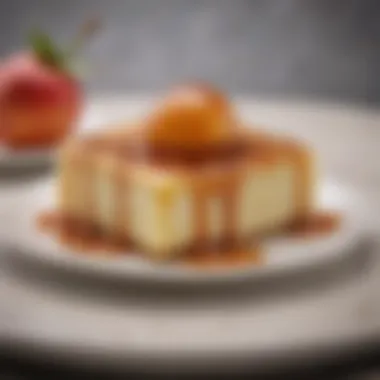Explore Monkfruit Simple Syrup: Recipe & Uses Guide


Intro
Monkfruit simple syrup has gained traction as a popular sweetener, especially among those seeking healthier alternatives to traditional sugar. This syrup is derived from the monkfruit, a small green gourd native to Southern China. The fruit is renowned for its sweetness, which comes from natural compounds called mogrosides. These compounds not only deliver a sweet taste but also offer potential health benefits, such as zero calories and anti-inflammatory properties.
In this guide, we will delve into the recipe for monkfruit simple syrup, its ingredients, and diverse uses in culinary applications. This information is important for those who wish to include more health-conscious options in their diet. By the end of the discussion, you will have a thorough understanding of the preparation methods and creative ideas for incorporating this syrup into meals and beverages.
Recipe Overview
Recipe Name
Monkfruit Simple Syrup
Description of the Dish
Monkfruit simple syrup is a versatile liquid sweetener that can enhance various drinks and desserts. Its low-calorie profile makes it an attractive option for individuals managing their sugar intake. This syrup is easy to prepare and can be used in cocktails, teas, smoothies, or drizzled over desserts. It promises a delightful sweetness without the health drawbacks associated with refined sugar.
Ingredients
List of Ingredients with Measurements
- Monkfruit sweetener: 1 cup
- Water: 1 cup
Special Notes on Ingredients
- Monkfruit Sweetener: Look for high-quality monkfruit sweeteners that are free from fillers and additives. Some brands may include erythritol, which is generally acceptable but may alter the syrup's texture slightly.
- Substitutions: If monkfruit is unavailable, a mix of stevia and erythritol can be a suitable alternative, but the flavor profile may vary.
Prelims to Monkfruit
Monkfruit, also known as luo han guo, has gained attention in recent years for its potential health benefits and versatility in culinary practices. This sweet fruit, native to southern China, offers a natural alternative to traditional sweeteners. The inclusion of monkfruit in modern diets illustrates a significant shift towards health-conscious choices, making it crucial to explore its properties and applications in the kitchen. Understanding monkfruit allows for greater appreciation of its role in creating healthier recipes, especially for those seeking to reduce sugar intake.
Understanding Monkfruit
Monkfruit is small, green, and has a sweet taste caused by mogrosides, compounds that are much sweeter than sucrose. Importantly, monkfruit does not contain calories or carbohydrates, making it appealing for individuals pursuing weight management or those with diabetes. In terms of flavor, monkfruit sweetener offers a mild taste without the bitterness that some artificial sweeteners possess. This quality makes it an attractive substitute for sugar in various dishes.
Monkfruit extracts are commonly used in packaged food products, beverages, and homemade recipes. When choosing monkfruit products, consumers should look for those without additives, ensuring a more purely natural sweetener. Notably, it's advisable to pay attention to the brand and concentration of monkfruit when buying, as some products may combine it with other sweeteners, which can affect both taste and health impacts.
The History of Monkfruit in Culinary Practices
Historically, monkfruit has been used for centuries in traditional Chinese medicine, where it was valued not only for its sweet taste but also for its purported health benefits. Historical records show that monkfruit was often brewed into teas or used in medicinal dishes to treat various ailments such as cough and sore throat. Over time, its culinary applications expanded beyond traditional practices as global interest in healthy living increased.
In recent decades, monkfruit has transitioned from a niche ingredient to a sought-after sweetener in the West as consumers seek alternatives to refined sugars. Its introduction into mainstream markets aligns with growing awareness around health and wellness, especially among those curious about natural food sources with minimal environmental impact. As a result, monkfruit has become a favored ingredient among chefs and home cooks alike, contributing to desserts, savory dishes, and drinks.
In summary, the exploration of monkfruit paves the way for a discussion on its culinary usage and health benefits. As we delve deeper into monkfruit simple syrup, it's essential to appreciate its origins and nutritional advantages, which position it as a viable option in contemporary culinary practice.
What is Simple Syrup?
Simple syrup is a staple in many kitchens and bars. It serves as a foundational element for sweetening beverages and enhancing dishes. Understanding its purpose is essential for any cook or mixologist. This syrup allows for even sweetness in drinks, ensuring that flavors blend seamlessly.
Definition and Purpose of Simple Syrup
Simple syrup is a liquid sweetener made by dissolving sugar in water. The common ratio is equal parts sugar and water, heated until the sugar is fully dissolved. The resulting syrup is clear and has a sweet taste.


The purpose of simple syrup is straightforward. It allows for quick and easy sweetening without the graininess of granulated sugar. This makes it particularly valuable for cold beverages, where sugar may not dissolve completely. It is commonly used in cocktails, iced teas, and lemonades.
Moreover, simple syrup can be infused with various flavors, such as vanilla or mint, adding another layer of complexity to drinks or sauces. This flexibility makes it a vital ingredient in both professional and home kitchens.
Traditional Simple Syrup vs. Monkfruit Simple Syrup
Traditional simple syrup, as mentioned, is primarily made of sugar derived from cane or beet. It offers quick sweetness but comes with caloric costs that some people seek to avoid. In contrast, monkfruit simple syrup uses monkfruit extract, which is a natural sweetener with minimal calories.
Here are some key differences:
- Calories: Traditional syrup contains a high caloric content, while monkfruit simple syrup is low in calories, making it suitable for those watching their intake.
- Flavor: Monkfruit provides a different taste profile, often perceived as having a clean sweetness without the aftertaste associated with some artificial sweeteners.
- Usage: Both types can be used in similar applications; however, the choice may depend on dietary preferences, such as a desire for low-calorie options.
In summary, while traditional simple syrup remains a culinary staple, monkfruit simple syrup presents an appealing alternative for those exploring healthier options. Understanding these differences enhances your ability to adapt recipes and create delightful beverages and dishes.
Health Benefits of Monkfruit Simple Syrup
Monkfruit simple syrup is not just a sweetener; it has numerous health benefits that make it an appealing choice for many. Understanding these benefits is essential, especially as more people seek healthier alternatives to traditional sugars. This section will delve into the specific advantages offered by monkfruit simple syrup, emphasizing its role as a low-calorie sweetener, its antioxidant properties, and its suitability for people with diabetes.
Low-Calorie Sweetener
One of the main attractions of monkfruit simple syrup is that it is a low-calorie sweetener. Unlike regular sugar, which packs significant calories, monkfruit provides sweetness without the accompanying caloric load. This property makes it an ideal sweetener for those who are monitoring their caloric intake or trying to lose weight.
Consider that one tablespoon of regular sugar contains about 48 calories. In contrast, monkfruit simple syrup can provide the same level of sweetness with just a fraction of those calories, making it a smart choice for those aiming for a lower-calorie diet.
- Calorie Comparison:
- Regular Sugar: Approximately 48 calories per tablespoon
- Monkfruit Simple Syrup: Usually less than 5 calories per tablespoon
This significant difference can contribute to better weight management, especially when used in beverages and recipes that require sweetness, allowing individuals to enjoy their favorite flavors without the guilt.
Antioxidant Properties
Monkfruit is derived from the monkfruit plant, known for its natural sweetness. Beyond its sugary taste, this fruit contains powerful antioxidants called mogrosides. These compounds may help protect the body from oxidative stress, which is damage caused by free radicals.
Benefits of Antioxidants:
- Cellular Health: Antioxidants can support cellular repair and reduce inflammation.
- Potential Disease Prevention: Some studies suggest that diets rich in antioxidants may lower the risk of chronic diseases, including heart disease and cancer.
- Eye Health: Antioxidants might also contribute to better eye health, possibly preventing conditions like cataracts.
Incorporating monkfruit simple syrup into the diet can help individuals increase their intake of antioxidants, all while enjoying a natural sweetness that does not compromise health.
Diabetic-Friendly Alternative
For those managing diabetes, monkfruit simple syrup offers a safe and effective alternative to traditional sweeteners. It does not cause significant spikes in blood sugar levels, making it suitable for diabetic individuals. This characteristic is vital, as controlling blood sugar is central in diabetes management.
Here's why monkfruit simple syrup stands out:
- Glycemic Index: Monkfruit has a glycemic index of zero, which means it does not raise blood glucose levels.
- Natural Sweetness: It's a natural product derived from monkfruit, avoiding the artificial ingredients often found in other sugar substitutes.
- Taste: It has a pleasant taste that many find superior to other non-sugar sweeteners, making it easier to integrate into daily meals and drinks.
"Choosing monkfruit simple syrup allows those with diabetes to indulge in sweetness without risking their health."
In summary, monkfruit simple syrup provides various health advantages, from being a low-calorie sweetener to possessing antioxidant properties and serving as a diabetic-friendly option. These factors render it a valuable addition to the diets of various individuals, particularly those looking to reduce sugar intake without sacrificing flavor.
Preparing Monkfruit Simple Syrup


Understanding how to prepare monkfruit simple syrup is essential for anyone who wants to efficiently incorporate this low-calorie sweetener into their culinary repertoire. The process of making monkfruit simple syrup is straightforward yet rewarding, allowing you to create a versatile ingredient that adds sweetness without unwanted calories. Additionally, it is important to consider the freshness and quality of the syrup, as this can affect the flavor and health benefits it offers.
Ingredients Needed
To prepare monkfruit simple syrup, you need a limited number of ingredients, which makes the process accessible for all home cooks. Here are the key ingredients:
- Monkfruit sweetener: This can be found in various forms such as granulated, powdered, or liquid. The choice depends on personal preference.
- Water: Filtered water is generally best, as it can enhance the purity of the syrup.
The ratio of monkfruit sweetener to water can vary. A common starting point is one cup of water to one cup of monkfruit sweetener, though adjustments can be made based on desired sweetness and flavor intensity.
Step-by-Step Preparation Process
Making monkfruit simple syrup is an easy task. Here is a straightforward, step-by-step guide to help you through the process:
- Measure the Ingredients: Start by measuring equal parts of monkfruit sweetener and water.
- Combine in a Saucepan: In a medium-sized saucepan, combine the water and monkfruit sweetener.
- Heat: Place the saucepan over medium heat, stirring occasionally. The goal is to dissolve the monkfruit sweetener completely without boiling the mixture.
- Simmer: Once dissolved, you can let the syrup simmer for a few minutes to enhance the flavor. This step is optional as monkfruit has a sweet profile that does not require extensive cooking.
- Cool Down: After simmering, remove the saucepan from heat and allow the syrup to cool. This step is vital to ensure that the syrup can be stored safely.
- Store: Transfer the cooled syrup into a clean bottle or jar. Make sure to label it for future use.
This preparation will yield a sweet, versatile syrup that can complement various dishes and drinks.
Storage Tips and Shelf Life
Proper storage is key to maintaining the quality and shelf life of monkfruit simple syrup. Here are a few important considerations:
- Storage Container: Use a clean, airtight container to minimize exposure to air, which can degrade the syrup.
- Refrigeration: Store the syrup in the refrigerator. When kept properly, it can last for about one month, though its flavor may begin to diminish over time.
- Signs of Spoilage: Always inspect the syrup before use. If you notice any unusual odor, color changes, or mold, it’s best to discard it and make a fresh batch.
Proper storage will help you enjoy the sweet benefits of monkfruit simple syrup for longer while maintaining its healthy properties.
Culinary Uses of Monkfruit Simple Syrup
Monkfruit simple syrup is more than a mere sweetener. It offers multiple culinary possibilities that cater to diverse tastes and dietary needs. Its low-calorie and natural profile make it a suitable alternative, allowing both home cooks and chefs to explore this syrup's versatility. Using monkfruit simple syrup can transform various meals and drinks, ensuring that sweetness does not compromise health.
In Beverages
Coffee and Tea
Using monkfruit simple syrup in coffee and tea can enhance the flavor profile without adding excessive calories. It acts as a sweetener that dissolves quickly, allowing for a smooth, well-balanced drink. Traditional sugar may overpower delicate tea flavors, while monkfruit syrup maintains the integrity of the beverage, ensuring the natural tastes shine through. The benefit lies in its ability to sweeten without the sugar-related drawbacks, making it a popular choice for health-conscious individuals.
Cocktails and Mocktails
Monkfruit simple syrup can elevate cocktails and mocktails with its distinct sweetness. Bartenders increasingly lean on it as a sugar substitute, creating drinks that look appealing and taste fresh without the guilt. For those avoiding alcohol, monkfruit syrup adds dimension to mocktails, ensuring flavor remains robust. One possible disadvantage is that it might require adjusting the recipes, as its sweetness level differs from sugar.
Smoothies and Shakes
The incorporation of monkfruit simple syrup into smoothies and shakes allows for easy moderation of sweetness levels. Since these drinks are often made with fruits, the syrup can complement the natural sugars present without overwhelming them. Furthermore, its low-calorie nature aligns well with health trends, promoting guilt-free indulgence. However, finding the right balance is essential, as too much syrup could mask the fresh flavors of the other ingredients.
In Cooking and Baking
Breakfast Dishes
Integrating monkfruit simple syrup in breakfast dishes provides an easy way to sweeten items like oatmeal or pancakes. This syrup complements various breakfast foods while offering a healthier option for those reducing calorie intake. The characteristic sweetness does not change the texture of the dishes, making it suitable for cooking. Yet, careful measurement is crucial, ensuring the right sweetness level is achieved in each recipe.
Desserts


Monkfruit simple syrup can be an exceptional sweetener in desserts. As desserts are often high in sugar, replacing conventional sweeteners with monkfruit can result in lower-calorie treats. This substitution allows for the creation of brownies, cakes, and puddings that maintain flavor integrity. However, it may create a different consistency compared to sugar-based recipes, requiring experimentation to achieve desired results.
Marinades and Dressings
In marinades and dressings, monkfruit simple syrup introduces a sweet-savory balance without the excess calories. Whether preparing grilled meats or salads, the syrup can enhance flavors, making dishes more appealing. Such versatility allows for healthier culinary creations while preserving taste. However, the sweetness can sometimes take away from other strong flavors if not properly balanced.
Comparison with Other Sweeteners
In the landscape of sugar alternatives, it's vital to understand how monkfruit simple syrup measures up against other sweeteners. With an increasing number of consumers seeking healthier options, comparing monkfruit to alternatives like stevia and erythritol becomes crucial. Such comparisons not only highlight each sweetener's unique attributes but also help individuals make informed dietary choices. While the spotlight often shines on calorie content, it's equally important to consider taste, usage flexibility, and any health implications associated with these sweeteners.
Monkfruit vs. Stevia
Both monkfruit and stevia are derived from natural sources and are popular choices for individuals looking to reduce sugar intake. Monkfruit is extracted from the monkfruit plant, while stevia comes from the leaves of the Stevia rebaudiana plant. Here are some points of comparison:
- Taste Profile: Monkfruit simple syrup has a sweetness that is often described as more rounded and less bitter compared to stevia, which can have a somewhat licorice aftertaste for certain individuals.
- Caloric Content: Both are low in calories, but monkfruit is typically lower due to its concentrated sweetness, with minimal extra processing.
- Additives: Many stevia products combine stevia with other fillers or sweeteners, which may affect nutritional values. On the other hand, monkfruit syrup tends to be more straightforward in composition, especially when homemade.
- Common Uses: Monkfruit syrup excels in both beverages and cooking, while stevia is widely used to sweeten drinks and as a sugar substitute in baking, though the outcomes may vary.
"Monkfruit syrup offers a natural sweetness with little to no aftertaste, often preferred in culinary applications for its versatility."
Monkfruit vs. Erythritol
Erythritol is a sugar alcohol that stands out in the realm of low-calorie sweeteners. It is often used in various food products, including low-carb or sugar-free items. Here's a comparison between monkfruit and erythritol:
- Sweetness Level: Monkfruit is about 150-200 times sweeter than sugar, while erythritol is around 70% as sweet. This can lead to different quantities needed in recipes.
- Digestive Tolerance: Erythritol can cause digestive issues in some people, such as gas or bloating, especially when consumed in large amounts. Monkfruit, on the other hand, does not have these digestive drawbacks, making it more user-friendly for many.
- Taste and Aftertaste: Both provide a clean and sweet taste, but some users report a cooling sensation with erythritol that can alter the flavor profile of certain dishes. Monkfruit syrup tends to provide a smoother finish without these sensations.
- Applicability: Monkfruit syrup can be seamlessly integrated into various recipes, circumnavigating the cooling effect of erythritol, which is more noticeable in beverages.
In summary, both monkfruit and its counterparts, stevia and erythritol, have advantages and disadvantages. Understanding these differences can help individuals choose the most suitable sweetener for their culinary needs and health goals.
Considerations and Precautions
When incorporating monkfruit simple syrup into your diet, it’s crucial to understand several considerations and precautions. Awareness of potential allergies, proper usage guidelines, and moderation in consumption can greatly enhance the overall experience with this sweetener. This section aims to provide clarity on these important aspects, ensuring individuals make informed choices while using monkfruit syrup.
Possible Allergies and Sensitivities
Monkfruit is generally recognized as safe for most people; however, some may experience allergic reactions or sensitivities. Although rare, individuals with known allergies to melons should exercise caution. Monkfruit belongs to the gourd family, which includes watermelon and cantaloupe. Symptoms of allergies can vary, ranging from skin irritations to gastrointestinal discomfort.
It is advisable for new users to start with small amounts of monkfruit syrup and observe any adverse reactions. This trial approach can help in identifying potential sensitivities. Always consult with a healthcare professional if you have concerns or experience unusual symptoms after consumption.
Proper Usage Guidelines
Using monkfruit simple syrup effectively requires understanding proper guidelines. Here are some essential points to consider:
- Serve in Moderation: Although monkfruit is low in calories, it's best to consume it in moderation. Excess sweetening in one's diet can lead to misuse, defeating the purpose of healthier alternatives.
- Adjust Recipes Carefully: When substituting monkfruit syrup for traditional sugar in recipes, keep in mind that it can have a different sweetness level. It is often sweeter than sugar, which means less may be required. Start with half the amount of syrup and adjust to taste.
- Mixing with Other Ingredients: Monkfruit syrup can blend well with many drinks and dishes, but always mix thoroughly to ensure even sweetness. Shake or stir well to achieve desired flavor in drinks such as coffee and cocktails.
- Storage Practices: Store monkfruit simple syrup in a cool, dark place to maintain its quality. Always check for any changes in aroma or color before use.
Following these guidelines will enable a safer and more enjoyable experience with monkfruit simple syrup.
Ending
Recap of Health Benefits and Culinary Potential
To recap, the health benefits of monkfruit simple syrup are noteworthy. It is derived from the monk fruit, a natural source that avoids the negative impacts of refined sugar. The absence of calories is crucial for those mindful of dietary restrictions. Additionally, its antioxidant capabilities can contribute positively to overall health. Notably, monkfruit syrup serves as a diabetic-friendly option, making it an accessible choice for those managing blood sugar levels.
In terms of culinary potential, its applications are vast. It can sweeten a range of beverages, including coffee, tea, and cocktails, while also serving as a valuable ingredient in cooking and baking. The unique flavor profile of monkfruit syrup allows for indulgence in desserts and marinades without the guilt of high sugar content. This combination of health benefits and culinary versatility positions monkfruit simple syrup as a valuable addition to any kitchen.
Final Thoughts on Incorporation into Diet
Incorporating monkfruit simple syrup into your diet can be a game changer for health-conscious individuals. Transitioning from traditional sugars to this alternative not only supports a healthier lifestyle but also encourages experimentation in the kitchen. It is essential, however, to consider individual tastes and dietary needs. For those unfamiliar with monkfruit products, starting with small amounts in recipes can allow for adjustment to its flavor and sweetness.
"Adopting monkfruit simple syrup into your meals and drinks offers a simple pathway towards healthier eating and living."
Ultimately, the willingness to try monkfruit simple syrup can lead to beneficial changes. The blend of reduced calorie intake with delightful flavors can certainly reshape how one perceives sweetness in food and beverages. Ensuring a balanced approach while incorporating this syrup into daily recipes can yield satisfying and healthful outcomes.







